🎹 UPDATED REVIEW
| Nov 1, 2023 – Kawai VPC1 88-key Digital Piano Controller | Recommended | Kawai is well known throughout the world for building high quality upright and concert grand acoustic pianos and they even produce a line of pianos called “Boston” for the Steinway piano company. So it comes as no surprise that Kawai produces a digital piano controller that does a very good job of reproducing a grand piano key action playing experience beyond that of conventional digital piano controller keyboards which connects to virtual grand pianos (computer software generated piano sounds) giving you that 9′ concert grand piano sound experience.The VPC1 has Kawai’s professional wooden graded hammer piano key action with simulated ivory grand piano keys allowing for a great keytop feel featuring a grand piano let-off/escapement function, 3-sensor key electronics for authentic sound dynamics and sensitivity, high speed core compliant USB/MIDI connectivity, all housed in an attractive satin black piano style top. The VPC1’s chassis is engineered from industrial aluminum & steel with a reinforced
keyboard base providing extra stability when playing big chords, and yet it is portable (although it is a bit heavy) and looks like a piano without the stand or base. It’s designed to give the piano player the best “key action feel and piano response” (because of its advanced 3-sensor key electronics) you can get in any regular digital piano “controller keyboard.” No other brand comes close right now to this model when it comes to a pure “controller” digital pianos which control external computer based piano sounds that are not inside the digital piano itself.
 |
| MP11SE |
If you prefer an “all-in-one” solution with great key action made of wood for all 88-keys and has impressive built-in sounds, then the Kawai MP11SE portable piano with built-in Kawai stereo piano sounds and useable control features (so that you don’t have to connect to an outside source for sounds and functions) might be the one for you. The MP11SE key action is also more advanced and realistic than the VPC1 and has a lighter, quicker response and movement as compared to the VPC1 key action. However, the MP11SE is $3499 so it’s another $1100 more than the VPC1. For the people who want to think “outside the box” and want something very simple and a bit more elegant in design, and don’t mind connecting devices together and using virtual or MIDI instrument sounds, then the Kawai VPC1 is definitely a winner and nothing else comes close to the way it looks or plays for what it does.
So who is the VPC1 primarily made for? Well it really is made for people (anyone) who want to play piano, have something somewhat portable which can be used with headphones or external stereo monitors, and they want to keep the price down while getting a high quality piano playing experience by using high quality virtual grand piano sounds. These virtual piano sounds come from computer software developed by piano software companies who produce specialized grand piano sounds taken and sampled directly from famous acoustic pianos such as Steinway, Bosendorfer, Yamaha, and others.
However, the extremely difficult part of reproducing a real grand piano playing experience in a digital piano is not only the having the right key action and key electronics for authentic dynamics, but also having the correct velocity touch curves (left pic on computer monitor) when playing the keys on the digital piano. A velocity touch curve, generally speaking, is the ability of that piano sound to come out naturally & dynamically in reproducing subtle volume changes from soft to loud as well as the subtle dynamics of the the sound from mellow to bright when pressing the keys. No matter what the piano sound sample is by itself and no matter who makes it, it may not sound and play right unless you have a digital piano controller keyboard action that is or can be geared to these individual virtual piano sound libraries and their particular velocity curves and dynamics.
So that means that just connecting a good quality piano controller keyboard to a laptop computer with great piano sounds is just half the equation. The other half (and best scenario) is for that piano controller to be designed by a piano company (like Kawai) along with the cooperation of those piano sound companies to come up with the right software inside the “controller piano” to control and play the software virtual piano sounds the way they were meant to be played and heard. That is another thing that makes the VPC1 so special…it has those specific velocity touch curves and dynamics approved by the piano sound software companies so you can correctly play the grand piano sounds from those companies such as Ivory, Pianoteq, & Galaxy, to name a few.
The VPC1 is designed to make the playing experience using virtual grand pianos quick and painless, but many pianists and
software musicians who use virtual pianos (as they are referred to) enjoy customizing their setup too. For
those users, the VPC1 includes a dedicated software editor, providing
greater control of their sound setups including advanced
MIDI routing. Individual setups can be created for different needs and
stored to a memory preset in the piano (there are five of them), and then recalled without a
computer using a simple key control on the piano… that’s pretty cool:). There is even laptop space on top of the VPC1 to fit a computer along with the piano having a music rest, which is not the norm for “controller digital pianos.” The piano even comes with a
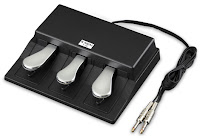
portable but yet durable and heavy weight 3-pedal foot unit for playing traditional acoustic piano style using damper with half-pedal, sostenuto, and soft pedal control.
Another huge factor in considering the purchase of a VPC1 and using it to control virtual piano software on a laptop computer, is the computer itself. It would need about 85-90 gigs of free disk space to comfortably hold something like the piano software from Synthogy called Ivory II. Ivory II reproduces 3 full size 9′ concert grand pianos in nearly every way with an organic sound experience (using a Kawai VPC1) that you likely have never encountered playing a digital piano. Other virtual piano software such as Pianoteq do not require the same power or memory space in a computer that Ivory does so it really depends on what virtual piano software you choose. You can definitely enjoy yourself with other software like Pianoteq, galaxy, or others, so there are certainly great options compared to “Ivory.”
Getting the piano sound to be great when using a piano controller takes a lot of things. It takes a great piano keyboard action, a great piano sound source, a place (a fast and efficient laptop computer with plenty of power, memory, and hard drive space) to store the virtual piano sounds, and a great speaker system (and headphones) to reproduce those fabulous virtual piano sounds as they were intended to be heard such as the ones on the Ivory program by the Synthogy company. There is a cost to all of that once you put it all together and when you add it up you’re likely pushing more than $4000 for everything if you are starting with nothing. If you already own any of these components, then your cost would obviously be less. To save money you could use a laptop if you already had one as long as it could meet minimum requirements for the intended software,
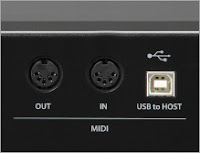
and if you already owned an appropriate external speaker system then that would cut down cost, even if that system was not as good as it could be.
However, if you want to use the Kawai VPC1 and have your playing experience be the best possible outcome at a reasonable price and you did not already own any of the necessary equipment, then you would probably need to spend close to $4000 or more to get it. But if you think about it this way; three new 9′ concert grand pianos would cost you well over $300,000 and you would need a huge amount room to put them in (and that’s why those piano sounds take up so much space on a computer hard drive, because those pianos are so big!), so spending a bit over $4000 and getting it all to fit in a much smaller space is a real bargain and I think it is worth it for that “real acoustic concert grand piano playing experience” in a digital piano!
| Kawai VPC1 |
I would definitely recommend the Kawai VPC1 playing experience to anyone not afraid of or opposed to having the necessary component setup to achieve the intended result. I will admit and agree that you may not want this setup in a more formal living area, but that’s OK because there are nice full size upright style digital pianos that fit that purpose, such as the Kawai CA49 or CN301, and you can have a great playing experience on those pianos too and in many cases, even better. But with regard to the VPC1, I can also recommend some piano virtual software for a good grand piano sound experience as well as the right speaker systems, stand, bench, headphones, etc that would work best for you. I would also recommend that you consider avoiding pre-packaged or bundled setups offered on web sites because they may not be the best solution to what you’ll need. Please contact me and I can give you more info and help you make the right decision on your piano purchase.
If you want more info on new digital pianos and LOWER PRICES than internet discounts, please email me at tim@azpianowholesale.com or call direct at 602-571-1864.




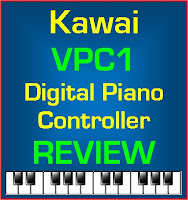
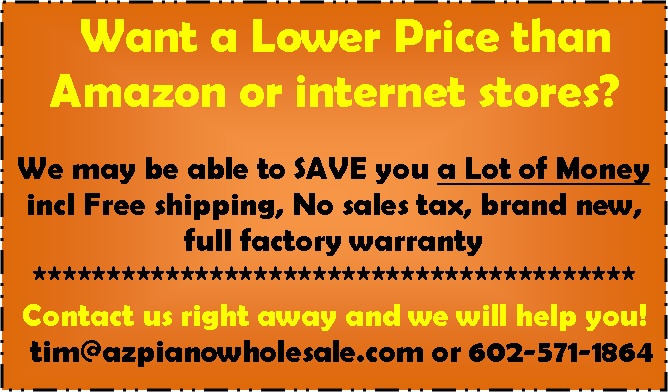
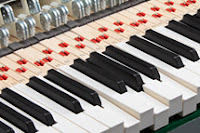
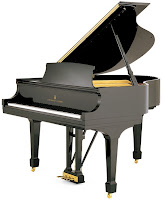
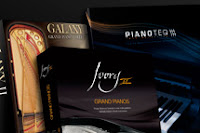
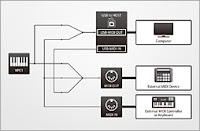
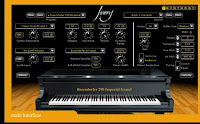











The Pianoteq software requires 20MB in total. It is not a huge collection of samples which requires 10s of GB disk. It is a tiny program, that any cheap laptop can run. There are free demo versions with Pianoteq on the web. If you look at youtube, there are piano pros that review Pianoteq. And if you use a decent headset, you get very good sound too when connecting it to a cheap laptop. Everybody already has a laptop and a headset, and you can get Pianoteq for $100. So, it will only cost you $100 in total. Not $4000.
Nice review, but most of it talked about how to connect the piano to the PC, and what equipment was needed and how much that costs. I am more interested in knowing about the piano.
How was the piano itself? Did you like the feeling of the keyboard? Touch? Was it in par with a real grand piano? Which features are included? What did the piano lack, compared to a real grand piano? Could you please update the review with some information about the keyboard?
Roland A-88 is a similar keyboard, using the same action as Roland FP4 I heard. Have you tried it, and compared it?
Thank you for your comments and points well taken, I have updated my review to reflect answers to your comments. I have no comments here on your specific Roland question however. You are welcome to email me on that one.
Do real Grand Pianos have aftertouch or it is just Digital Piano thing?
It seems to be a nice keyboard.
It seems to be their almost best keypad, http://www.kawaius.com/main_links/digital/Features/new_actions2010.html.
Why it is missing aftertouch? Is not that essential?
Thanks for the review Tim!
How did you rate the keyboard action when compared to the Kawai ES7?
after-touch is a synth/effects controller function and this instrument was primarily built to be a piano and control a piano so it does not have that function and doesn't need it.
it is not "missing" anything. It has what it needs to be a piano and control piano sounds
both very good actions but the wooden key action is far superior in the VPC1 and other Kawai wood action digital pianos
Thank you, Tim!
After doing research on the internet (and reading your thoughts), I have ordered Synthogy Ivory II Grand Piano software and Kawai VPC1.
Can't wait to get my hands on it. 🙂
Keep up the good work!
I received the VPC1 and Ivory Grand Pianos II.
I am really happy with them in sense of quality.
At first Kawai VPC USB-Midi did not work on OS X, but I installed Yamaha USB-Midi drivers and problem was solved.
I am a bit disturbed that I had to pay 300 euros for Ivory and iLok and iLok blue light makes me upset (it is not spaceship that I wanted.) Also it seems that I loose my iLok I can't play piano any more. (Licence was copied to there and nowhere else I can't store copy, not even on iLok.)
In overall everything besides iLok is more than I expected. iLok is awful and I hope that in Ivory III they don't use that stupid thing. If someone wants its possible to crack anything and why do they make honest clients life unpleasent?
I am really interested in this I had no idea that Kawai would go out and create the ultimate Piano Controller! Really Ivory II pianos sound better then digital pianos to my ears. Maybe the Way higher ones have a better sound. Bet I have gone out plays real pianos then played digital pianos and tested Ivory II to be closer to Real Pianos!
Thanks for review!
something for me to consider as I am still trying to figure out my digital piano options for advance user.
and Anonymous ilok is amazing! I have two both holding tons of licenses there nothing wrong with it.
Steven
Does having triple sensors make a significant difference? The MP10 seemingly doesn't have that but does it matter a great deal?
"…so you would need to purchase a portable metal stand that you would use for other portable digital pianos and I can tell you which one I would recommend."
Which stand would you recommend?
I have a digital Yamaha baby grand which I love. Looks good, sounds good, very nice piano feeling. AND the necessary volume control, my living conditions do not allow an acoustic. However, I also bought the budget version of Pianoteq, which cost 99 euro, just for fun, and I think it is excellent and much better than Ivory II – okay, so you don't need my opinion on THAT. The action on the Yamaha is very good – do you have the possibility to compare this with the VPC1?
It seems that we'll get a second home to alternate with and so I need a second piano for practicing when I'm there. My idea was to buy a smaller but still good quality digital piano or keyboard and use it together with my Pianoteq. The VPC1 seems to be just what I have asked for and the price is reasonable.
I also want to know about that metal stand. I just hate those fragile little stands where the piano starts to jump around if you try some heavy action Chopin, I want the feel of a solid piano.
I picked up an Omega stand and it is excellent for the VPC-1. I hooked it up to my PC and bought some edifier spinnaker speakers that look like horns. These are actually great because the down-firing woofers put some vibration on the low end. I love the action of my Yamaha NU1 but the VPC-1 delivers in that area too, and it's quieter than any keyboard I've played with. If you buy it, you won't regret it. My favorite libraries so far are the Galaxy Vintage D, Alicia's Keys (a Yamaha C3), and the Ravenscroft 275
I don't think that Omega stand is the best solution for VPC1, MP11 etc. if person needs rock-like stability. Because I saw various videos with this stand + these instruments, and K&M Omega was still wobbling sometimes. I think K&M 18950 would be better solution than K&M Omega. Even KAWAI itself chose that stand for their demonstration of MP11 digital stage piano:
https://www.youtube.com/user/kawaimpseries/videos
And you can see that the instrument remains completely stable on it. And one person from KAWAI also thinks, that K&M 18950 absolutely the best keyboard stand for stage digital pianos:
http://www.pianoworld.com/forum/ubbthreads.php/topics/2239205/Kawai_James.html#Post2239205
Bump! That was my reaction too. I want a perfectly stable stand, no matter how heavy it is. Which should I get?
Hi Tim, thanks for your review about VPC1. just wanna ask if you've tried another midi controller, FATAR's Studiologic SL88 Grand which also has wooden keys. and if the answer is yes, how would you compare them together? any reply would be thankful
@Tim Praskins
Thank you for this write-up. I really enjoyed reading it, and you brought up points that most reviews do not touch on, so thank you for the additional context. I am posting here because I found my way to your review based on the January 2017 update heading. I am curious that if you still have the VPC1, have your opinions of the device changed? Has it held up to long-term use since this original review was posted?
Again, thanks for the review and I look forward to reading your latest opinions.
I have owned my VPC1/Ivory 2 for about 4 years now and it has never let me down in quality or quality. I use a set of B&W 804D2's for my output to get the literal best sound possible, so really, the cost of a real piano is about where Im sitting now. Ive done Hollywood level compositions on it and have been considered for a few soundtracks as well. I can't imagine a better level, other than the Ravenscroft VPC1. However Im not sold on the pricetag vs quality for that vs the VPC1, hence why I have a VPC1 🙂 You can't do any better, currently than a VPC1, IMHO, and I continue to search for such a product, but have yet to find it. The writeup here is pretty bang on, and if you have the hardware already, I fail to see why a true pianist would ever hesitate on a product of this level if they can afford it. It's pretty much a nobrainer 🙂
The Fatar pedal unit really lets the VPC1 down. I'm on my 3rd now and it's starting to jitter erratically like the previous 2. All fine apart from that but it's it a bit of a deal breaker TBH.
So, no after touch will keep me from buying it! Too bad!